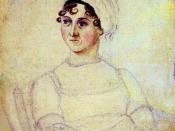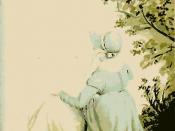Henry James, in Washington Square, provides a direct challenge to our preconceived notions of the novel of manners, notably through his chosen ending for the novella. After developing an idea about these principles through the works of Jane Austen, the reader may reasonably go into James's story with an expectation of a bright finish - but he refuses to conform his work to meet these hopes. With the conclusion of Washington Square, James impedes both the romantic and rational expectations of the audience and forces the reader to redefine their concept of a reasonable and realistic ending.
The end of this novella undoubtedly frustrates the reader's romantic instincts - the same instincts that Jane Austen endeavored to gratify. In fact, James chooses specific language that directly corresponds with Austenian literature in several instances. One example of this is the shared use of the dancing metaphor. Throughout her works, Austen focuses on dancing as a representation of relationships - and although James maintains this implication, the focus of the two authors is nearly opposite.
Austen focuses on the dance, and often places great importance on the conversations that occur during the event. James focuses instead on the absence of dancing - "She has had her little dance, and now she is sitting down to rest. I suspect that, on the whole, she enjoys it" (James 201). This statement, made by Dr. Sloper, is in complete contradiction with Austenian principles - in her novels, a heroine never enjoys being left out of a dance. Another example of James's carefully chosen references is the mention of Catherine's affections and their broken spring - a phrase which calls to mind the language used to describe Mrs. Smith in Persuasion. This narrative, upon examination, seems to have a direct relation to Miss Sloper in...



Book analysis /Jane Austen
Not Bad... good use of verbage, and debatable statements. Useable info for citing or comparative analysis.
1 out of 1 people found this comment useful.